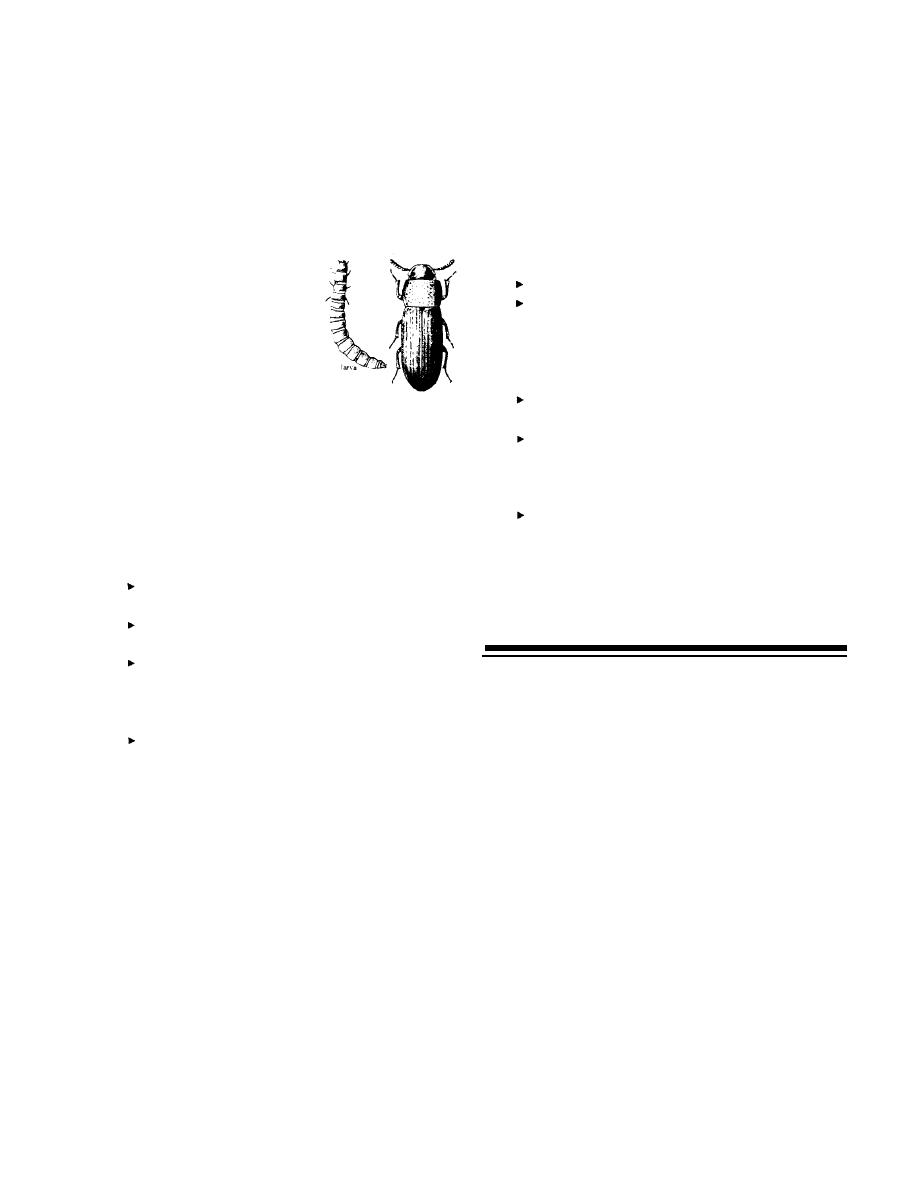

Custom Search
|
|

|
||
 The variety of foods they infest is inexhaustible:
Locate the infested material (beginning with
flour, cornmeal, all broken cereal grains, fish meal,
spices) and discard all infested products. Follow-up is
seeds (including tobacco seeds), spices, dried fruit,
seldom needed.
dog biscuits. In museums they infest skins, hair, wool,
FLOUR BEETLES
feathers, textiles, insect specimens, leather goods,
Tribolium castaneum and T. confusum
brushes and wooden artifacts. Other materials include
Two common species of similar flour beetles
soap, rat, mouse, and house fly manure, mammal and
infest dry milled cereal products in flour mills, retail
bird nests, decaying animal and vegetable refuse and
food stores, and homes. Other closely related species
even opium cake.
are found from time to time, but the two that are best
known are the Red Flour beetle
Inspection
and the Confused Flour beetle.
Use sticky traps or cockroach monitors.
These beetles are about 1/8 inch
When small infestations of spider
long, reddish-brown in color,
beetles are found, search for their
with short, stout antennae.
source.
Larvae are slightly longer than
adults, creamy-white, with few
Habitat Alteration
hairs.
Discard the product source; clean
Only those flour mills with the most thorough
thoroughly.
cleaning programs keep populations of Flour beetles
Eliminate all clutter and unused
low. [These beetles can live on flour spills.] Packaged
products.
milled cereals such as flour, cornmeal and cake mixes
bought in large quantities may be stored long enough
Pesticide Application
to allow eggs or larvae that have slipped through the
Apply spot treatments in cleaned, non-
milling and packaging process to develop.
food areas.
Control and Management
Follow-up
Inspect processed flour products and
A monitoring program using sticky traps should
discard those that are infested.
be followed until the population is eliminated.
Recommend a sanitation and cleaning
program for mills.
Recommend that stored products be
rotated, bought in smaller quantities,
and older packages discarded if use is
PESTS OF MOLDY, DAMP, OR OUT-OF-
not planned.
CONDITION GRAIN AND GRAIN
Follow-up in homes is usually not
PRODUCTS
needed. Retail food stores and
Milled or ground cereals and cereal-based
warehouses should have ongoing
products become heavily infested with fungi and
monitoring programs.
bacteria when their moisture content is high. Many
SPIDER BEETLES
insects feed on the decaying organic matter that
involves starches, proteins, certain vitamins, and other
A number of species of these small, oval beetles
chemicals produced in the process of decomposition by
are scavengers on stored products. Spider beetles
microorganisms. Spoiled products may include animal
range in size from less than 1/8 inch long to nearly 1/4
foods, milled cereals, flour spills, caked milled grain.
inch long. They have long legs and antennae. Their
Pests can be found in unclean grain storage elevators,
abdomens are usually oval and much larger than their
barns, and mills as well as in kitchen pantries and
head and thorax combined. Most species have short
cabinets with moisture leaks or ineffective ventilation.
hairs covering their thorax and wing covers; several
The infesting pests are scavengers whose nutritive
common species have shiny, hairless, globular wing
requirements are met by fungal-infested cereal
covers making them look like large mites.
products; they can develop into large populations.
Spider beetle larvae are white and grublike. Pupae
These pests include grain beetles, mealworms, and
are enclosed in silk cases covered by the materials they
mites. Two merit special attention:
infest; they look like lumps of the stored product.
Module One, Chapter 4, Pg 5
|
 |
|
 |
||